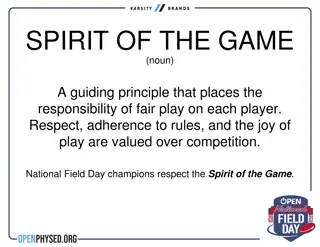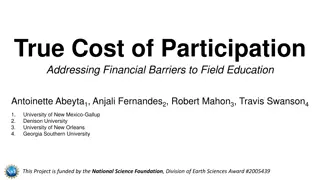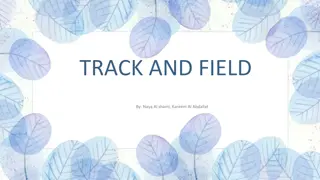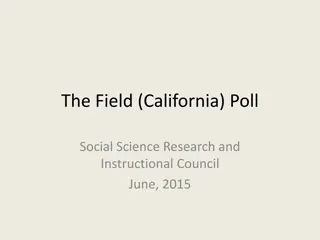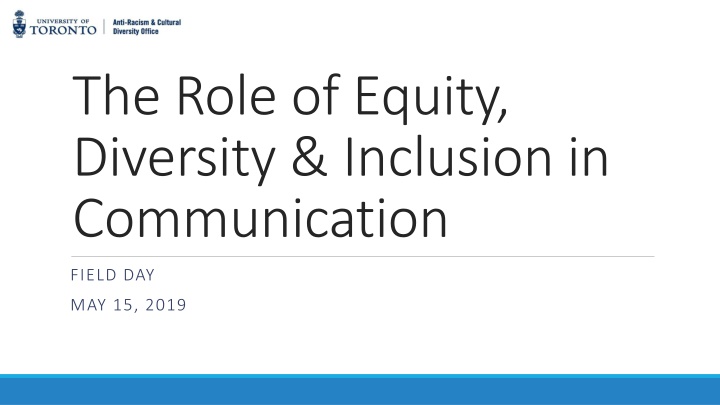
Exploring the Role of Equity, Diversity, and Inclusion in Communication
Discover the crucial role equity, diversity, and inclusion play in effective communication. Learn about honoring the land, promoting antiracism initiatives, and fostering a culture of diversity and inclusion. Understand the significance of storytelling in communication and how it can drive organizational change and promote motivation.
Download Presentation

Please find below an Image/Link to download the presentation.
The content on the website is provided AS IS for your information and personal use only. It may not be sold, licensed, or shared on other websites without obtaining consent from the author. If you encounter any issues during the download, it is possible that the publisher has removed the file from their server.
You are allowed to download the files provided on this website for personal or commercial use, subject to the condition that they are used lawfully. All files are the property of their respective owners.
The content on the website is provided AS IS for your information and personal use only. It may not be sold, licensed, or shared on other websites without obtaining consent from the author.
E N D
Presentation Transcript
The Role of Equity, Diversity & Inclusion in Communication FIELD DAY MAY 15, 2019
Honouring the Land Honouring the Land We wish to acknowledge this land on which the University of Toronto operates. For thousands of years it has been the traditional land of the Huron-Wendat, the Seneca, and most recently, the Mississaugas of the Credit River. Today, this meeting place is still the home to many Indigenous people from across Turtle Island and we are grateful to have the opportunity to work on this land.
There are no new ideas. There are only new ways of making them felt. Audre Lorde, Writer, Feminist, Civil Rights Activist
Validation/ Naming Antiracism & Cultural Diversity Office Approach Centre Race Identify Build Bridges Connect /Give Space
Build Capacity for Antiracism Initiatives on Campus Support Strategic Planning processes and initiatives to address systemic racism Role of the Anti-racism & Cultural Diversity Office Education & Training Programs Consultation & Complaints Support Location: Health Sciences Building 155 College St. Community Outreach & Resources Hub Anti-Black Racism Awareness & Response Email: antiracism@utoronto.ca
Diversity = Differences The Code/ Legislation Inclusion = Glue Attitude/ Respect Inclusion Communication Policies, practices/ Diversity is the mix; Inclusion is getting the mix to work well together Commitment
Story telling Role of Communication? Give voice Information sharing Debunk myths Disrupt/perpetuate stereotypes Supports organizational change Sets the tone for the culture, climate and personality of an organization/institution Source of motivation
Equity Diversity Inclusion As a result of historical and present-day systemic barriers encountered by under- represented and under- served groups, processes, policies and practices must be developed/adapted to ensure all individuals are provided with equal opportunities to obtain successful outcomes in all aspects of a person s life. The presence of a wide range of human qualities and attributes within an individual, group or organization. Including age, sex, race, ethnicity, physical and intellectual ability, religion, sexual orientation, educational background and expertise. Using, valuing and appreciating differences in a way that honors and shows respect for the individual and ultimately creates a dynamic multi- dimensional organization. Adapted from the Ontario Human Rights Commission, Glossary of Key Terms
Equity Inclusion Diversity Diversity Identities Matter
It begins with you
Diverse Diverse Workplace policies and practices Representation of Staff Representation of Clients Team Dynamics and Cohesion Indigeneity Truth & Reconciliation Recruitment Services and Resources
Allyship For EDI Allyship Video
Tips for Inclusive Communication - Develop and utilize an equity, diversity and inclusion lens - Be champions of equity, diversity and inclusion with your clients - Engage with community, aka - experts
Tips for Inclusive Communication - Avoid the use of stereotypes and descriptors that portray groups of people as dependent, powerless, or less valued than others - Avoid generalizations based in race or ethnicity. Do not assume that a person's appearance defines their nationality or cultural background - When referring to gender identity it is important to be aware of and use all-gender terms and phrasings.
Tips for Inclusive Communication - Hold yourselves and team members accountable in fostering the principles of equity, diversity and inclusion within the work environment for eg., workplace culture and recruitment - If using images, ensure the imagery pool is filled with diverse bodies - Do not allow fear to hinder meaningful change










